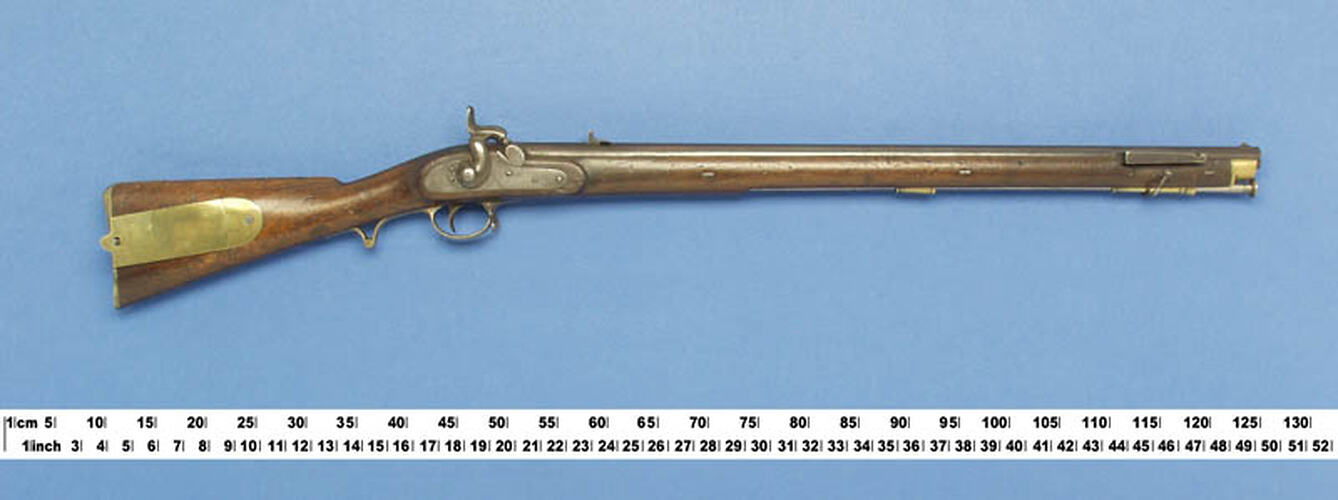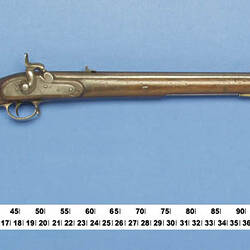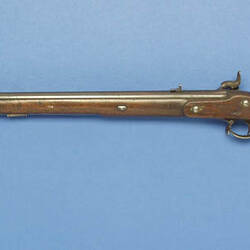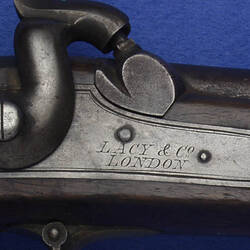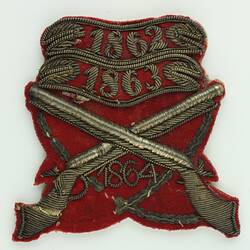Summary
British Service percussion rifle, Brunswick Rifle, 2nd model, cal. .704 in., steel rifled (two groove) round barrel, 765 mm long, with bayonet bar with front notch on R.H.side. Made by Lacy & Co., London, late 1840s.
One of 26 guns donated in 1871 by the Victorian Ordnance Department from its Melbourne Armoury, for the newly created Industrial and Technological Museum. The display was intended to show mechanics and gunsmiths the principles of gun construction and recent technical developments in weapons.
Physical Description
Steel side lock and hammer on R.H. side, brass oval triggerguard with small front spur and downward rear extension, no sideplate, brass foreend, butt plate and hinged patchbox on R.H.side, two sling swivels, one mounted from triggerguard, the other above front ramrod tube. Barleycorn foresight, V-notch rear sight, barrel fastened to stock via three barrel keys, steel ramrod with brass tip and breech end, 76.20cm long, and two brass ramrod tubes, the front one being trumpet shaped. Ordnance marks stamped on underside of stock near triggerguard. Buttplate tang stamped '13'. Good original blueing.
Significance
The Brunswick Rifle, the percussion version of its flintlock predecessor, the Baker Rifle, was produced in two models. The first featured a back-action lock, which was approved for replacement to the sidelock of the second model - exampled here - in August 1841, though it wasn't until 1845 that rifles in this configuration were produced in quantity. A later variation to the second model moved the notch on the bayonet bar from the front back to the centre of the bar. The change was instigated by the London gunmakers, Lacy & Reynolds, and though approved for adoption in mid 1848, it is likely that only the final batch of Brunswicks produced in 1850 adopted this modification, therefore, dating this example to the approximately five year window between 1845-50. The Brunswick was replaced by the Pattern 1851 Minnie Rifles, was subsequently issued out to militia and volunteer regiments. Five hundreds Brunswicks were issued to the New South Wales Volunteers on their formation in 1854 by Queen Victoria.
More Information
-
Collecting Areas
-
Acquisition Information
Donation from Melbourne Armoury, 24 Oct 1871
-
Manufacturer
-
User
Victoria: Ordnance Branch, Melbourne, Greater Melbourne, Victoria, Australia, circa 1845-1870
-
Inscriptions
Stamped on lockplate: LACY & Co/ LONDON Stamped on stock underside with ordnance marks
-
Model Name or Number
-
Brand Names
-
Classification
-
Category
-
Discipline
-
Type of item
-
Overall Dimensions
116 cm (Length), 6.1 cm (Width), 19.7 cm (Height)
Barrel length: 76.50cm
-
References
[Book] Penrose, Edgar H. 1949. Descriptive Catalogue of the Collection of Firearms in the Museum of Applied Science of Victoria. 161. 14.
-
Keywords
Rifles & Muskets: British, Rifles & Muskets: Military, Victorian Colonial Defence Forces
